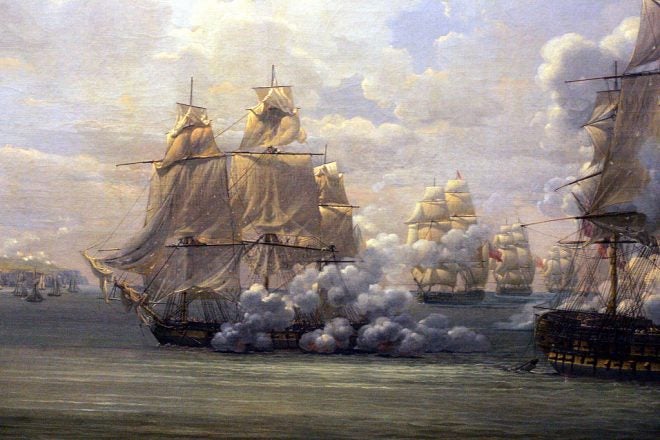It’s time for another trip in the TFB Time Machine; to a window of time when the seas were host to tall, wooden ships of the line, powered by green energy before it was cool, battling for dominance of trade and territory. To that end, one of the tools employed was the cannon, or rather, a LOT of cannons. Cannons had many intended consequences, such as to disable an enemy ship’s rudder, masts, sails, armament, and any of the ship’s personnel that happened to be in the way of reaching those goals. Cannons of various sizes were used, typically differentiated by the weight of the projectile it was designed to fire, ranging from the smaller 8 pounders, to 12 pounders (which is the same weight as a standard high school shot-put to put it in perspective), 20 pounders and on up to 36 pounders and above.
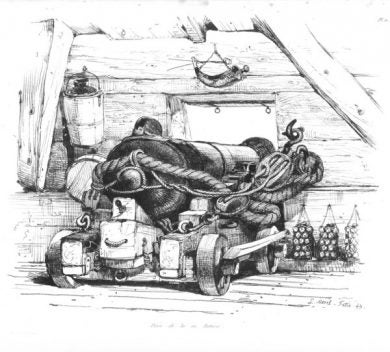
36 pounder gun, by Antoine Morel Fatio from Wikipedia
The small window of time mentioned above refers not to the tall sailing ships that ruled the waves for centuries, but a phenomenon within that time that seems to be more narrowly observed around the early to mid 19th Century. One of the unintended consequences of cannon fire was injuries and deaths attributed to what became known as the “Wind of Ball” theory. Naturally, getting hit with a cannonball of any size would certainly disrupt tea time, to say the least. However, one would think that having a cannonball miss you completely would be cause for celebration, but numerous doctors of the time noted that there were men injured or dead without a mark on them. As best as the doctors could tell, assisted by testimony from crew members that were near the casualties at the time of death, asserted that the “wind” from the cannonball had been the cause.
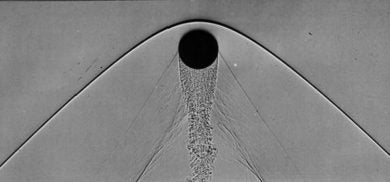
Schlieren photograph of a sphere moving through the air.
In the book “Gunshot Injuries, Their History, Characteristic Features,…” (1895, pages 132-136) by surgeon Sir Thomas Longmore, there are several pages dedicated to this topic, which were reprinted from his 1862 publication “A Treatise on Gunshot Wounds” (starting at page 32). In the segment “Subcutaneous contusions without external marks” the author mentions that despite the victim showing no external marks, their internal organs have become “viscus” or “lacerated” and that “a strong tendon like the tendo-Achillis has been ruptured, without any mark having been left by the shot on the skin; symptoms of cerebral concussion have shown themselves, or rupture of a sinus and fatal effusion of the blood has occurred, yet no lesion to the scalp has been detected.”
The author also states that most campaigns contained records of such wounds, including broken bones with no external damage visible. According to Sir Thomas, “These accidents have usually resulted from the grape or round shot in former use, but occasionally follow the stroke of a large fragment of shell having a smooth and convex surface.” He also concluded that it was not just small or large round shot that could cause such injuries, but odd-shaped fragments as well. I recommend looking at the link for the specific examples he gives that support the concept. Although he also states that “proof against the supposed force exerted indirectly through pressure of air by a passing shot has been obtained by experimental trial” (see appendix note on that trial below).
Another frequent observer of such injuries, Baron Larrey, argued that the ball had actually come into contact with the person, but somehow “rolled over” the affected area and changed the course of the projectile. This belief still concluded that the elastic skin would not have been affected, but that the organs under it would have been crushed.
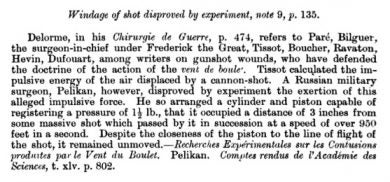
Sir Thomas Longmore’s appendix note on testing Wind of Ball procedure.
Although “wind contusion” injuries and deaths were frequently observed, there were other cases in which ears and tips of noses were shot off and even hair shaved off of the head without any other sign of internal damage. Which led Sir Thomas to conclude that the degree or angle of the shot played a part in whether or not someone suffered immediately following the passing ball.
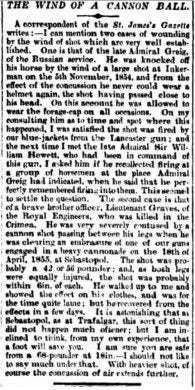
Excerpt from the Brisbane Courier, author unknown, January 2, 1890 edition.
Sir Thomas also noted that both the French and British had observed this phenomenon and the picture above documents at least one Russian incident. I also found one American account from action between the USS Kearsarge and the CSS Alabama during the Civil War, in which a man aboard the Kearsarge was believed to have been knocked down from the wind of a shot. The after-action correspondence didn’t claim to know how heavy the actual ball was that knocked the man down, but Alabama was said to employ 32 and 68 pounders as well as one 110 pounder. The whole battle was thought to take place between 1000-900 yards.

Author’s photo of the USS Constellation (2nd of her name) in Baltimore, MD
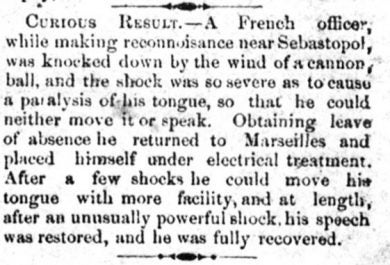
Excerpt from The Southern Enterprise, September 21, 1855.
Having some experience with the Spanish language, I was curious if Spain or Portugal had any records on the subject. That bit of research was abruptly cut short upon learning that “Wind of Ball” directly translated, refers to a fútbol (or, a soccer ball, for those that insist on only using the red, white and blue crayons). I asked my Son-In-Law, who is fluent in Spanish to search for any documents relating to the Wind of Ball topic. He was unable to find any definitive documentation, but it doesn’t mean the Spanish didn’t observe any Wind of Ball casualties. To our bilingual readers, I lay the challenge upon you, to find references beyond the English language pertaining to Wind of Ball type injuries or deaths. Other terms have been used for the theory as well; such as “Wind of the Shot”, “Vent de Boulet” and “Wind Contusions”. Please post what you find in the comments section!
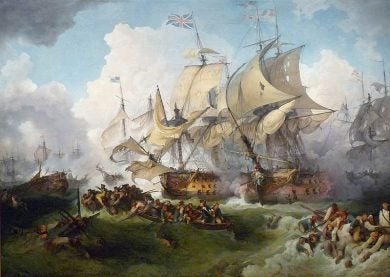
Philip James de Loutherbourg – Lord Howe’s action, or the Glorious First of June from Wikipedia.
The topic of Wind of Ball appears in internet forums from time to time. Even though there have been noted cases taking place on land, it seems most commonly associated with naval battles. It’s even briefly mentioned in the fictional, Master and Commander book series by Patrick O’Brian and the non-fiction book, Six Frigates by Ian W. Toll. One of the possible factors to this is that naval battles in the Nelsonian era were fought at short distances when the velocity of the shot was still at its peak. The one thing that typically seems to be missing from the accounts of doctors and captains is the distances of any two combatant ships when the Wind of Ball injuries or deaths occurred. So, given the manner of naval battles of the era starting at several hundred yards and closing to board and capture, especially with deck clearing grapeshot still being fired within several yards of boarding, which could lend the theory some credibility.
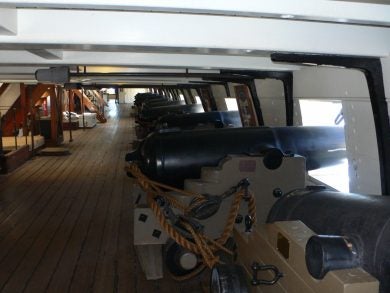
Author’s photo of the USS Constellation’s (2nd of her name) gun deck in Baltimore, MD.
In searching for velocities from cannons of the era, I found a site dedicated to the HMS Victory museum ship. They claim that a 32 pounder achieved a velocity of 1600 feet per second. The picture below shows calculated velocities and was posted on a gaming forum, but the topic was about realistic velocities and oak penetration. The source mentioned in the picture is said to be from the Aide Mémoir Navale and seems to be close to the 1600 fps mentioned in the HMS Victory page. The picture mentions that the “Ballistic Pendulum” was used to calculate the velocities, which is an interesting topic on its own.

Aide Mémoir Navale velocities for various projectile weights and guns. Apologies for the poor quality image.
Despite the documentation available to us in this age of communication, skepticism still remains; ranging from dismissing the notion outright, to those that believe the injuries were from being jostled, tossed, or thrown into other objects. I also read one opinion that it was not the movement of air coming off the projectile, but instead, a drastic change in pressure, which the body or parts of it couldn’t handle. With modern examples of cannons being used in the Middle East, there’s a chance such injuries or deaths could be seen again, but with such limited use, it’s doubtful. There are no modern tests of the theory of Wind of Ball that I’m aware of, nor are there any YouTube videos dedicated to the subject.
The closest example available to us would be the video of a hunter nearly missing (but still killing) a deer with a .50BMG. Matt at Demolition Ranch tested this theory to some degree and it appears that wind is not the deadly factor, however, a modern pointed projectile does differ in shape and mass of a cannonball.
Where do you stand on the topic? Is there something to it, or is it just wind?
 Your Privacy Choices
Your Privacy Choices
